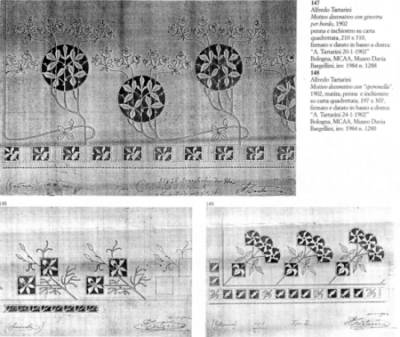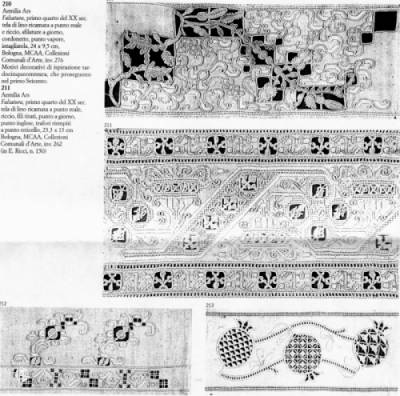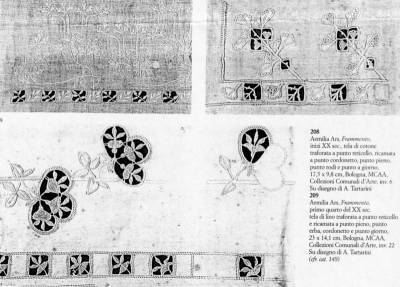
| ANNE WANNER'S Textiles in History / book reviews, articles |
| C. Bernardini, D. Davanzo
Poli, O. Ghetti Baldi (eds) Aemilia Ars. Arts & Crafts Bologna 1898-1903 published by Musei Civici d'Arte di Bologna and A+G edizioni, Milan, 2001, text in Italian, bibliography, illustrated in colour and black and white sent by Pat Griffiths |
| The important part played by needle lace and whitework embroidery in the Bologna arts and crafts society Aemilia Ars is reflected here by the fact that the articles on this branch constitute the major section of this book, which accompanied the recent exhibition in Bologna and in which they are described and discussed in the context of Aemilia Ars as a whole. The society as such was forced to go into liquidation, but the lace and embroidery section kept going until 1936 and even after that important work was done in the two techniques and the shop in Bologna called Aemilia Ars ceased to exist only a few years ago.In the first of three articles on the lace and embroidery |  |
| Doretta Davanzo Poli sets these against the national and international background of the time, describes the technique and gives an account of the history of the society. A second article by Rosaria Campioni discusses the 16th-century pattern books from which the movement drew inspriation. Finally, in a long article Vittoria Capechi and Adele Pesse discuss the question of why this part of the enterprise lasted so long, while the remainder part failed. The needlework section owed no little of its success to the energy, initiative and sagacity of Contessa Lina Bianconcini Cavazza, the leading light behind it, who, for example, herself made three trips to Paris to secure outlets for the work. This branch was a non-profitmaking entreprise, over 50% |  |
| of the takings going to the workers, 600 of them by 1902, 800 by 1914. Another important aspect was the variation of the amount of work on pieces, so that not everything needed to be so expensive. A high technical standard was always maintained, however. No opportunity was missed of participating in international and national exhibitions in both Europe and the United States and exports played an important part in the running of the operation. |  |
| The large number of illustrations and the fact that the lace and embroidery enterprise is shown here in the context of Aemilia Ars as a whole make this book a must for any museum with a lace and embroidery collection. It further contains biographies of all the leading artists and designers involved in the enterprise and is in general a very welcome amplification and extension of the book of 1929 by Elisa Ricci. |
| home content | Last revised June 10, 2001 | For further information contact Anne Wanner wanner@datacomm.ch |